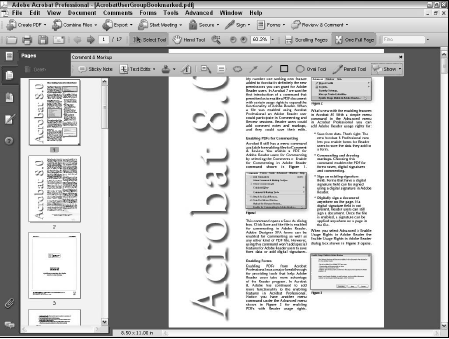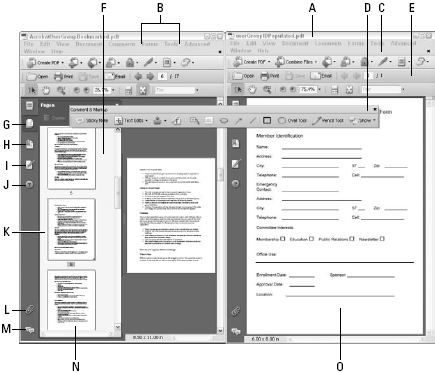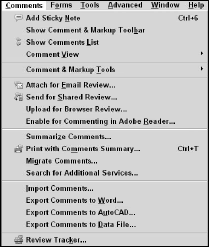Acrobat 8 Menus
If you’re an Acrobat user, the first thing you’ll notice when you launch Adobe Acrobat 8 or Adobe Reader 8 is a new appearance for the user interface (UI). Many changes have been made to the Acrobat window, some of which you may like and others you may not. I’ll explain more about the user interface later.
For now, let me share the reasons why Adobe has made the current significant changes to Acrobat 8. Adobe Systems is a company committed to user feedback and responding to user needs. Most often, we find changes being made in Acrobat, and all of Adobe’s products, as the result of a demand by a significant number of users.
For instance, you might wonder why a great feature is removed from one version of the product. The answer may simply be that a number of IT managers were struggling with a security loophole caused by the feature.
The change in Acrobat’s user interface was made because of a large demand by enterprise users who want Acrobat to appear similar to other programs used, such as the Office products and Web browsers.
You may not agree, but Adobe can only respond to the majority and the majority is asking for something similar to the look and feel of the current release. Such changes require all of us to become familiar with some new ways to move around a document and become familiar with the way your documents appear in an Acrobat window.
As you can see in Figure below, the Acrobat workplace has changed appearance. For those familiar with earlier versions of Acrobat, you’ll notice some obvious changes in the user interface.
- Color Scheme. The Acrobat window has changed color because many users want to have more emphasis on the document page and less on the Acrobat workspace.
The contrast in color between the background Document pane color emphasizes document pages more when the pages are white. White is the most common page color used by most users.
- Elimination of the Status Bar. You’ll notice immediately that the familiar Status bar in Acrobat 8 is now absent. This decision was made to provide more viewing area for document pages. If you like having tools previously found in the Status bar in view, don’t worry.
- Icons in the Navigation pane. Another obvious change in the user interface is the appearance of icons in the Navigation pane at the far left side of the Acrobat window. Again, this change was made to provide users more space in a crowded window.
In earlier versions of Acrobat, we saw names for the Navigation panels, such as Bookmarks, Pages, Security, Comments, Attachments, and so on.
These names took up quite a bit of real estate especially if you loaded a number of additional Navigation panels made available by selecting View >> Navigation Panels and selecting a panel from the submenu.
After dragging a panel to the Navigation pane, the panels quickly begin to crowd the available space. By using icons, you can easily store more individual panels in the Navigation pane.
- Document windows with toolbars. This user interface change was again made because of strong demand from users who wanted Acrobat to appear similar to other Windows and Macintosh programs.
Although the view departs from Adobe’s Creative Suite programs, Adobe found more users of Acrobat working in Microsoft Office and Internet Web browsers.
Separate document windows with toolbars associated with each window was the demand and Adobe responded. You can choose in a preference setting whether to view PDF documents with or without toolbars attached to each document.
Acrobat provides you with features such as menu commands, toolbars, and palettes to accomplish work for whatever goal you hope to achieve with PDF documents. When you launch the program you see many of these features in the Acrobat window.
Just so you know what is being referred to when I discuss accessing a feature in Acrobat, take a look at Figure below to understand the names used to describe the various areas of the new Acrobat workplace.
- Title bar. By default, the name of the file you open appears in the title bar. The title appearing in the title bar can change according to an option for displaying the Document Title in the Initial View properties.
- Menu bar. The menu bar contains all the top-level menu commands. These menu choices are also available from various actions associated with links and form fields when you choose the Execute a menu item command in the Actions Properties dialog box for links.
Form fields, and other features that permit associating an action with a command. When viewing files showing toolbars and menus for each open document, the Acrobat window appears as shown in Figure above. This view can be toggled off in a preference setting.
- Toolbars. A number of individual toolbars are nested below the menu bar. When preferences are set to view toolbars attached to each open document, you’ll see multiple sets of toolbars. Toolbars are marked with a vertical separator bar at the left side of the toolbar. This bar can be selected and dragged to move it out of the Toolbar Well.
- Floating toolbar. Toolbars can be opened by accessing the More Tools drop-down menu and selecting a toolbar name. When a toolbar is opened, it appears as a floating toolbar. Floating toolbars can be docked in the Toolbar Well.
- Toolbar Well. The Toolbar Well houses the toolbars. You can drag toolbars away from the Toolbar Well or add other toolbars and expand the Toolbar Well to house your new additions. When you drag a toolbar away from the Toolbar Well, the toolbar is “undocked” and becomes a floating toolbar. When you drag a floating toolbar and drop it in the Toolbar Well, the toolbar becomes “docked.”
- Palette pull-down menu. Individual panels can be tucked away in the Navigation pane (see Navigation pane later in this list) or appear anywhere in the Acrobat window. Each palette contains its own menus accessible by clicking the down-pointing arrow.
- Pages panel. When you open the Pages panel, you’ll see thumbnail images of each page in your document and you’ll find many page-editing features available to you from the Pages panel palette pull-down menu.
- Bookmarks panel. The second default panel appearing in the Navigation pane is the Bookmarks panel. If bookmarks are contained in the PDF document, they appear in the palette when the palette is open.
- Signatures panel. If digital signatures are included in your PDF document, they can be viewed in the Signatures panel.
- How To. The How To pane has been moved in Acrobat 8 to the Navigation pane. In Acrobat 7, this pane appeared on the right side of the document window. The How To pane contains some help information related to many common PDF editing tasks. Users of previous versions of Acrobat will notice the How To pane has replaced the default appearance of the Layers pane.
- Page thumbnails. When the Pages panel is opened, page thumbnails of all the document pages appear within the Pages panel.
- Attachments. The Attachments pane is used to show all file attachments in a document.
- Comments panel. When you open the Comments panel, the display of comments and reviews is shown horizontally at the bottom of the Acrobat window.
- Navigation pane. The Navigation pane can be expanded or collapsed. To open the Navigation pane you can click a panel to display the respective information associated with that panel in the expanded palette window. Clicking again on the panel collapses the view. You can also use the keyboard shortcut F4 to expand and collapse the Navigation pane.
- Document pane. The Document pane is the container for PDF files you see in Acrobat. When no file is open, the Document pane is empty. When you open a PDF document, the document appears in the Document pane.
Menus
As with any program operating on a computer system that supports a Windows type of environment, you’ll notice menu commands at the top level of the Acrobat window. Users of previous versions will notice that Acrobat 8 features an additional menu that contains commands specific to creating PDF forms.
If at first glance you don’t see an option you used in Acrobat 7, poke around the menus. None of the Acrobat 7 features have been eliminated; they may just be in a different place or referred to by a different name.
- File menu
The File menu is where you open and close documents, create PDF files, import and export certain data, access print commands, and find some other nifty new additions in Acrobat. The Mac and Windows operating systems display recent files in different menus.
On the Mac in OS X you’ll find recently viewed documents by choosing File >> Open Recent File. This command opens a submenu where you can access recent documents. On Windows, a list of the recently viewed documents is located at the bottom of the File menu.
- View menu
The View menu contains all the commands you’ll use for viewing PDF documents. An addition to the View menu is the Reading Mode command. This command dismisses the Navigation pane and appears similar to the display you see when reading articles. The Wireframe command has changed to Line Weights you see at the bottom of the menu.
- Document menu
The Document menu contains a collection of commands specific to document handling. Options in the Document menu have a few changes in Acrobat 8 compared to the options in Acrobat 7.
Notice a new command—Enable Features in Adobe Reader, which appears in addition to Enable for Commenting and Analysis found in Acrobat 7 and used to enable PDFs for commenting in Reader. This new command now enables you to add both commenting and saving from data in Adobe Reader.
The Paper Capture command has changed names to Scan to PDF and a new command exists for optimizing scanned PDF files. The OCR feature in Acrobat remains the same and is all available in the Text Recognition submenu. In addition to these new commands, we find the Examine Document command and Manage embedded index appearing in Acrobat 8.
- Comments menu
Some new menu commands in the Comments menu shown in Figure below include Send for Shared Review, Upload for Browser-Based Review, Search for Additional Services, and a number of different export commands for exporting comments to MS Word, AutoCAD, and to a data file.
- Forms menu
The Forms menu is new to Acrobat 8. Here you’ll find a number of different commands all used for working with PDF forms and Adobe Designer XML forms (Windows).
- Tools menu
The Tools menu in Acrobat logically places access to many editing tools in a single convenient menu. You can access certain tools from the Acrobat toolbars or you can use a context menu to access toolbars from the Acrobat Toolbar Well.
- Advanced menu
The Advanced menu contains a collection of menu commands considered to be advanced Acrobat features. A few of these tools are not available to users of Acrobat Standard such as Batch Processing, the new Redaction tools in Acrobat 8 Professional, and access to Acrobat Catalog.
A few changes have been made in this menu in Acrobat. You’ll notice the Security commands have changed a bit and a new command exists for enabling PDFs with Adobe Reader usage rights.
Also notice the Document Processing menu command. From the submenu you find many command that were positioned directly under the Advanced command such as Batch Processing, And JavaScript commands.
- Window menu
The Window menu provides menu commands to assist you in viewing documents.
- Help menu
The traditional help files added to your Acrobat folder at installation are found in the Help menu. Various online help support is also located in this menu. You’ll note that the Detect and Repair command found in earlier versions of Acrobat has changed to Repair Acrobat Installation.
- Submenus
An extensive number of submenus appear in menus contained in the top-level menu bar and from many different tools contained in toolbars. Note that on individual toolbars you see a down-pointing arrow. Clicking the arrow opens a menu; some menus contain submenus.
A submenu is denoted in Acrobat by a right-pointing arrow on the right side of a given menu command as shown in Figure below. Select a command with one of these arrows adjacent to the command name and a submenu opens. In a few cases, you can find nested submenus where another right-pointing arrow may be visible in a submenu.
If you want to access the second submenu, move the cursor to the menu option containing a right-pointing arrow. To make a selection from a submenu command, move the cursor to the desired menu command. When the menu command highlights, click the mouse button to execute the command.
- Context menus
Wherever you are in the Acrobat window—the toolbars, palettes, Document pane, or the Help menus— you can gain quick access to menu items related to your task by opening a context menu. Context menus pop up in an area where you either click the right button on the mouse or use an appropriate key modifier.
In Windows, right-click the mouse button to open a context menu. On a Macintosh, when not using a twobutton mouse, press the Control key and click the mouse button. Context menu options relate to the particular tool you have selected from a toolbar.
By default the Hand tool is selected when you launch Acrobat and open a PDF document. When you right-click the mouse button (Windows) or Ctrl+click (Macintosh), a context menu pops up where you click the mouse.
If you change tools in a toolbar and open a context menu, the menu options change to reflect choices with that particular tool. Likewise, a context menu opened on a palette offers menu options respective to the palette, as shown in Figure below.
Opening a context menu on one of the icons in the Navigation pane opens a menu where you can add or remove panels from the pane.
Additionally, you can hide the Navigation panel icons by opening a context menu in the Navigation pane and select Hide Navigation Pane Buttons. To bring back the Navigation Pane Buttons, press F4 on your keyboard or select View >> Navigation Panels >> Show Navigation Pane.
Context menus are a great benefit during your Acrobat sessions and using them helps you work much faster. Throughout this blog I often make references to the different choices you have in selecting a tool or command. In most incidences, you find mention of context menus.
- Keyboard Shortcuts
Pressing one or more keys on your keyboard can also open menus and invoke different commands. When you become familiar with keyboard shortcuts that perform the same function as when using a menu or context menu, you’ll find yourself favoring this method for making different menu selections or grabbing a tool from a toolbar.
Fortunately, you can learn as you work when it comes to memorizing keyboard shortcuts. As I’m certain you know, several shortcut combinations are noted in menu commands. You can learn these shortcuts when you frequently use a particular command.
However, the keyboard shortcuts you see in the menu commands are just a fraction of what is available in Acrobat for quick access to commands and tools. For a complete list of all keyboard shortcuts, look over the Complete Acrobat help document you open by selecting Help >> Complete Acrobat 8.0 Help.



